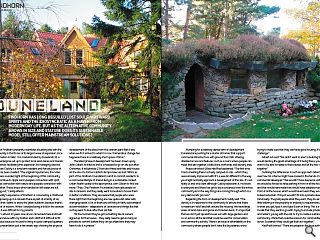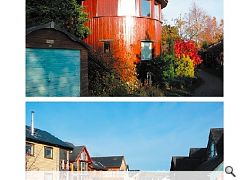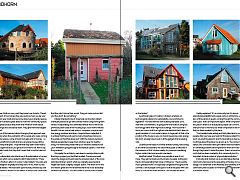Findhorn
13 Jan 2012
Findhorn has long beguiled lost souls, wayward spirits and the idiosyncratic as a haven from modern day life. But as the alternative community grows in size and stature does its sustainable model still offer mainstream solutions?
Much of Findhorn presently resembles a building site with the community in the throes of its largest wave of expansion since its formation in 1962. It is masterminded by Duneland Ltd, a social enterprise set up to protect local sand dunes and maram grass whilst facilitating this expansion. Its managing director, Jonathan Caddy, is a long term resident and fiercely proud of what has been created: “The original impulse here, the notes that were sounded right at the beginning of this community, they continue to ripple out in peoples connection with spirit, peoples connection with nature and peoples connection with each other. Those drops which landed on still water are still rippling out,” Caddy attests.Caddy’s experience of Findhorn is coloured by a childhood pent growing up in a caravan there as part of a family of six, “From that I learnt to enjoy the great outdoors because there’s not a lot of indoors. Whilst I enjoyed being a child in the caravan I think it was difficult for my parents.
“It’s almost 20 years now since I came back here and built my own house with my brother and I still find it difficult to fill the space because I’m used to living in quite cramped quarters. I did a presentation just a few weeks ago showing the physical development of the place from the caravan park that it was when we first arrived to what it is now. Tremendous change has happened here in a relatively short space of time.”
The latest phase of development has been drawn up by John Gilbert Architects and is scheduled to go on site just after Christmas. It will provide 23 two and three bed flats and houses on the site of a former rubbish dump known as East Whins as part of the Findhorn Foundation’s remit to commit residents to a communal lifestyle of shared living in a sustainable context. Urban Realm spoke to the eponymous John Gilbert to find out more: “They (The Findhorn Foundation) have got people on site in caravans and they really want to be able to house them in better conditions. They are aware that people who were there right from the beginning are now quite a bit older with changing needs. A lot of them are still living in fairly substandard accommodation – adaptations of caravans and things like that so they want to look after their old folk.
“At the moment they’ve got something like 14 owners signed up for the houses – they really need to get as many as possible to commit before they can go ahead and they may have to do it in phases.”
Plumping for a relatively dense form of development Duneland are pushing for a cluster of homes that support communal infrastructure with ground floor flats offering disabled access and features; such as a room where people can meet and eat together, a bike store, workshop and laundry area.
Project architect Gillies MacPhail explained: “The first time I had a meeting there I actually camped on site – which they were all really impressed with! It’s a wee bit different to the way you might normally approach a development of this size. It’s not really us and one client although Caddy represents it. He listens to everyone and there has got to be a consensus from the whole community as to the way things are coming through which is a very democratic process.”
Regarding the form of development Caddy said: “The density is in response to the community to ensure that there is maximum ‘wild’ land left around the housing. We have large areas of sand dune and gorse and bracken beds, it’s important that we don’t just spread houses out with large gardens and so on across all the land that could be used for conservation and community activity. There is an issue of affordability in this community where people don’t have the big salaries; we’re trying to make sure that they can have good housing. It’s a challenge.”
Gilbert echoed: “We didn’t want to erect a building that would destroy the great advantage of it being there, you want to be able to relate to these dunes and let the two come together.”
Outlining the differences in such an approach Gilbert mulled over how his scheme might have looked in the hands of a commercial developer: “We wouldn’t have live/work units and we would be forced to have parking in front of all the houses - and that would have meant we would have adopted roads in front of all the houses which would have meant they would have looked suburban. This just wouldn’t fit into a private developers mind really. They tell people what they want, they do very little tailoring of the property to anybody’s requirements. This is what you get, type A and type B sort of thing. This is a new model that they want to go with, trying to include private buyers and renters; young with the old, to try to create a sustainable community. I think that could be a lesson for communities across Scotland if they could get their act together.”
MacPhail chimed: “There are people in the local authority who know Findhorn very well, they know how it works. There’s an element of trust where they say we know how you lay your paths and your roads and we know about your amenity spaces. They don’t demand great detail on how the community spaces are supplied because they know that Findhorn know about these things and care about them. They give them that degree of respect.
“One of the reasons behind changing their approach was previously when they sold plots off to people who were coming from other places, some of them had quite a bit of money - so they could afford to build what are very large houses sitting on relatively small plots. They felt that they didn’t want that to happen again because you get a bit of a free for all. Not to say that it didn’t work, but they didn’t want that to be the future of Findhorn.”
One discordant note struck was in the elimination of curves, a decision which some residents didn’t take kindly to: “There was the Findhorn effect of course”, noted Gilbert. “Our plan was much straighter originally and they were ‘oh no, more curves’. MacPhail added: “We had been quite roundly criticised by a lot of the residents. Maybe it’s one effect of living in the community that they don’t mince their words. They just come out and tell you they don’t like something.”
Initially intended to be of straw bale construction Gilbert eventually elected to go with a timber frame using home grown timber, incorporating cross laminated timber floors which had previously been used at the Housing Expo. Each home will also benefit from air source heat pumps, sunspaces, sunpipes and low energy windows and doors. Despite these credentials it is unlikely that there will ever be many Passivhaus homes on the estate, as MacPhail observed: “With the indoors/outdoors lifestyle people like to keep their windows open for healthy living. For them being inside with your windows sealed and all your ventilation going through a mechanical system, is not what they’re about.”
Principally the architects were keen to avoid problems with their Expo property as MacPhail recalled: “because we went down the design and build route the actual product of the cross laminated timbers wasn’t what we originally expected and might have been a slightly cheaper option. The finish of it in the end wasn’t great and we’ve learned that it has to be absolutely protected at all times. You don’t want to get any kind of damp on the timber.”
A particular gripe of Caddy’s is today’s emphasis on technological solutions to sustainability, now enshrined in legislation: “It’s hard with the new building standards 2010, even with our intentions, of going down the route of using less technology rather than high tech buildings. The house that I live in just now is built to a high eco standard but that’s down to good insulation, it’s not rocket science. A huge part of that is the position of the house so you can maximise passive solar energy. We don’t actually have to put in all the gadgets that are being sold.
Located at the head of a former airfield runway, now acting as an entrance boulevard, the sites military past is reflected in the presence of RAF Kinloss nearby, its presence mandating higher certain blast and acoustic standards.
MacPhail noted: “Findhorn is as popular as ever, if not more. They get hundreds and hundreds of people visiting and they’re still expanding their range of influence – they’re pretty much globally known. It’s especially congested throughout the summer; a lot of people come just to look at the place with cars lining up outside the main entrance - not an ideal situation.”
Caddy explained: “It’s a community but it’s also an educational establishment people come in all the time, we have tens of thousands of guests coming through the community every year. That’s an important aspect. What’s important about this place is there is an actual place people can come to, not everyone has to live here, but what is important is the moral lift that has been created by this place.
“I’ve travelled quite widely and hitch hiked and so on, and people often say have you heard of this place called Findhorn. I don’t say anything about it and it’s fascinating to hear people tell me things about the place I’ve grown up in. The connection with nature, the connection with spirit rather than the material realm, it’s extremely powerful and important in their own lives even though they haven’t visited the place. There’s a transformative myth that has been created by this community but it is important to have a place of physical demonstration.”
Ironically what started out as an alternative lifestyle community has become the prevailing orthodoxy in housing design. It is testament to the flexibility and creativity of the community that 50 years on Findhorn is still at the forefront of sustainable design.
|
|
Read next: Fort William
Read previous: Govan Renewal
Back to January 2012
Browse Features Archive
Search
News
For more news from the industry visit our News section.
Features & Reports
For more information from the industry visit our Features & Reports section.





